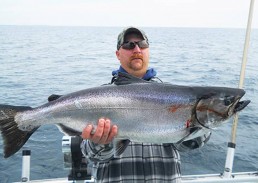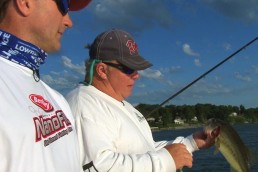What’s the Best Time of Year to Fish? June!
SHARE THIS POST
I get asked a lot of questions as a charter captain. In fact, I ask people to ask me questions. What is the number one question that I get year after year? It had to be, by a landslide, “When is the best time to come fishing?” Now that is a question that could get many different, interesting answers: “Any time you can,” or “Tell me what the weather is going to be like,” or an oldie but goodie, “When the fish are biting.” But seriously, “When is the best time to go fishing?”
During the summer months, I literally get to fish every day of the week. Now over the course of the season, we have good days and not so good days. I do manage to catch fish statistically about 98.5 percent of my trips over the years. Some days a few fish, some days lots of fish and some days a whole lot of fish. As guides, we do have a slight advantage in that we are on the water every day and can stay on patterns and also via cooperation between captains, we share information that helps all of us to stay on fish. But to answer the number one question, I think you have to consider the second most popular question, “What is the better time to fish, mornings, afternoons or evenings?”
There are a lot of reasons why I think June is the more consistent of the summer months for fishing Lake Michigan. Let’s explore a few of my theories. First, the near-shore fishery is just starting to “wake up” from the long winter, and as the water starts to warm near shore, we will see the baitfish start moving towards the shallows. Alewife, the preferred diet of salmon, will be coming to the shallows to spawn. When this happens the salmon will also be moving near shore to stay with their preferred food source. This normally happens in early June.
The next reason would be that once the water starts to warm up and we start seeing some thermoclines setting up, the fish become quite active. When this happens, the fish can feed not only in the early morning, but all day long. This can make for some pretty consistent catches throughout the entire day. It only makes sense that when you can find consistently active fish all day long, that is a great time to come fishing. The thermoclines are a great place to target steelhead. This is the time of year when middle of the day fishing can be the best time of the day to be on the water. “Steelies” are most active during the day and that makes June an excellent mixed bag opportunity to fill your cooler!
Using logic, one would expect the early part of the season to have the most fish available for anglers. With salmon and trout being “put and take” in Lake Michigan, you must realizing that just out of one harbor alone, literally hundreds of fish a day can be harvested out of the schools when you factor in the number of charter boats and private boats that are angling on the busy weekend days. Knowing this fact, by the later summer months, it would make sense that the schools are a little smaller than in the spring. There are still lots of fish around for the late season, as evident by the large runs of salmon each fall in our rivers, but with the larger schools of fish in June, the easier it is to find and catch them.
As water temperatures rise and the weather gets nicer, the salmon and trout tend to become more aggressive feeders as their metabolism picks up. They will feed and digest their meals at a very quick rate, thus, increasing the amount of time they spend feeding. That coupled with the larger numbers of actively feeding fish and limited bait make this a prime time to target these fish and fill up a cooler of grilling fare.
Are you enjoying this post?
You can be among the first to get the latest info on where to go, what to use and how to use it!
Probably the reason I like June fishing the most is the weather. After a long winter of cold temperatures and a steady dose of brisk, chilly north winds, I am ready for the calm, sunny, warm days that seem to show up in June. This is a time of the year that seems to have the calmest days, the least amount of wind and on average, a little less precipitation. That makes planning a fishing outing a little easier and actually getting out fishing a little more fun!
Normally, one would expect to catch the largest salmon in the fall. While the average size of the salmon may be a bit larger in the fall, over the last several years—for me at least—my biggest salmon of the season came in mid to late June. It’s probably because with the sheer numbers of salmon caught in June, when they are on the feed, the big salmon are very aggressive and trophy fish are going to be caught.
Why is all this great, early-season action possible? Well, a recent analysis of the lake-wide stocking program showed that the chinook salmon stocked by the Wisconsin DNR are outperforming the rest of the Lake Michigan basin. Illustrating the excellent returns of fish stocked by Wisconsin’s hatcheries, from 2011 to 2013, Wisconsin provided 38 percent of all the chinooks that were stocked in Lake Michigan. Yet from 2012 to 2014, Wisconsin stocked fish accounted for some 49 percent of stocked fish harvested throughout the lake and 57 percent of the stocked fish taken in Wisconsin waters. This further shows that the fish coming from the Kettle Moraine Springs and Wild Rose hatcheries are surviving better and providing an outstanding fishery for the anglers. Give a round of applause to our Wisconsin DNR Fisheries Team for giving us top value for our Great Lakes Salmon and Trout Stamp funds.
For current fishing reports or information on charter fishing in the Algoma area, check out my report page at FishAlgoma.com. You can even sign up for periodic newsletters and fishing reports. From Capt. Lee and the crew aboard the “Grand Illusion 2,” we are looking forward to seeing all of you on the water this spring.
Lee Haasch is an Algoma charter captain with 40-plus years of Great Lakes fishing experience. He’s been writing and giving seminars for 25-plus years. Contact: fishalgoma.com or 888-966-3474.
Tip of the Month
Early summer fishing as water warms up is generally in the top layers of the lake strata. What this means is most actively feeding fish will be in the top 60 feet of the water column, with the majority in the top 30 feet. Early morning, low light fishing is always pretty good, but what about when the sun gets higher in the sky and the lake is calm? Ever notice how your downriggers and diver sets work well early, but fade to nothing as the sun rises? Try running longer leads on your downrigger sets, and instead of Dipsy Divers, try running Slide Divers with Lite Bite feature. With Slide Diver sets, you can lengthen out your leads. In shallow water sets, I sometimes run 80- to 100-foot leads and my Slide Diver rigs become studs! With calm water and bright sun, your boat casts a shadow in the water that spooks fish. By getting your sets further away from the boat (deeper or farther back) you will increase your catch during bright daylight hours and the Lite Bite feature makes your divers release on the slightest bite.
MWO
SHARE THIS POST
Did you enjoy this post?
You can be among the first to get the latest info on where to go, what to use and how to use it!
Lee Haasch
Capt. Lee Haasch is a charter captain out of Algoma, Wis., with more than 45 years of Great Lakes angling and guiding experience. Haasch has been instructing anglers for over 30 years with education seminars and timely freelance articles.




Quite a good point! Even though I love fishing in the winter, the time that I fished during the summer months were my best fishing hauls